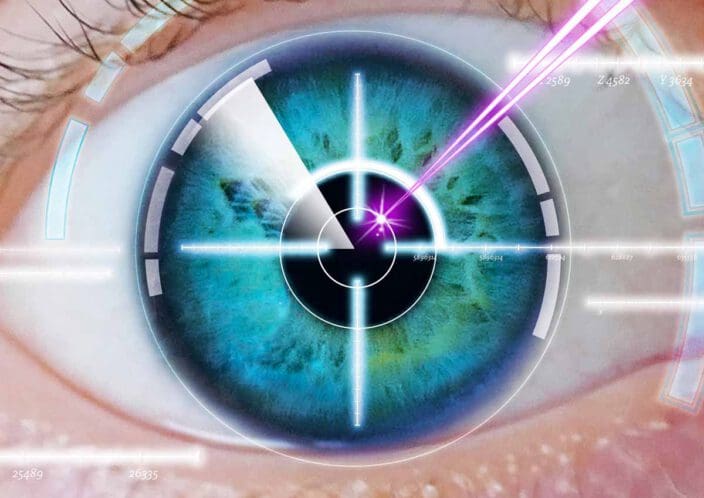
Medically Reviewed by Amarpreet Brar, M.D. NVISION Surgeon
What Does LASIK Feel Like? Before, During & After
Home / Laser Eye Surgery Guide (Updated) /
Last Updated:

Medically Reviewed by Amarpreet Brar, M.D. NVISION Surgeon

Article At a Glance
LASIK is generally painless due to numbing eye drops administered before the procedure. During surgery, you may feel slight pressure when a suction ring is applied to your eye. Post-surgery, it’s common to experience mild discomfort, such as itching, burning, or a gritty sensation, along with watery or blurry vision. These symptoms typically subside within a few days as your eyes heal.
One of the queries you may have before undergoing LASIK surgery is exactly how the procedure feels. Below is a comprehensive overview of the various steps involved in the procedure.
The First Step: Numbing Eye Drops
Before the LASIK procedure, the doctor will administer eye drops. The drops contain a local anesthetic and will be instilled directly on your eye. Local anesthetics block the nerves in your eyes from sending pain signals to your brain. Your cornea has more nerve endings than any other body part.
Numbing drops block pain during LASIK, reduce your natural urge to blink and make the procedure more comfortable. Getting the pre-procedure drops feels like any other eye drops. Your eyes will feel numb moments after the anesthetic washes across your eyes.
You deserve clear vision. We can help.
With 135+ locations and over 2.5 million procedures performed, our board-certified eye surgeons deliver results you can trust.
Your journey to better vision starts here.

Holding The Eye Open
By the time you are positioned under the laser system, the anesthetic will have taken hold, and you will not feel anything with your eyes. The doctor may give you medication to help you relax. An instrument known as a lid speculum will then be used to keep your eyelids open.
Since the numbing drops don’t work on your eyelids, you will be able to feel the instrument keeping your eyes open. Your eyes will naturally adjust to reduce blinking as they are held open. You can easily recreate this feeling by using your fingers to hold your eyes open. When you are undergoing LASIK surgery, the feeling will be similar.
During Surgery
- Creating the flap
- Reshaping the cornea
Creating the Flap
During Lasik surgery, the doctor will place a soft corneal suction ring to your eye to hold it in place in preparation for the flap creation process. You will experience some pressure during this process, which may be mildly uncomfortable.
The increased suction can cause vision dimming for a brief period in the eye being treated. This is often the most uncomfortable stage of the entire LASIK procedure. The eye surgeon then creates a precise hinged corneal flap using a surgical tool known as a mechanical microkeratome.
After creating the flap, the surgeon will remove the suction tool. Pressure will reduce, and your vision will clear up. You may experience blurry vision throughout the remainder of the LASIK procedure.
Reshaping the Cornea
The surgeon will move the flap and expose the underlying corneal tissue. The laser system will be positioned over your eye, and you will be requested to stare directly at the light. Depending on the type of laser utilized for your treatment, the light may have different colors.
Once you are in the proper position, the eye surgeon will turn on the laser, at which point you may notice ticking sounds and a strange smell. This is perfectly normal as the ticking sound is the sound of the laser pulses. The new smell is the fluid evaporating from the cornea during the ablation (reshaping) process.
Treatment often lasts less than 60 seconds, but the duration varies. After the appropriate laser ablation, the eye surgeon will replace the corneal flap to its original position. You will hear the LASIK treatment more than you feel. The process sounds like a fast click-click-click-click as the laser does its job.
You deserve clear vision. We can help.
With 135+ locations and over 2.5 million procedures performed, our board-certified eye surgeons deliver results you can trust.
Your journey to better vision starts here.
After LASIK Surgery
Following LASIK surgery, you may experience irritation, itching, or burning in your eyes. It may also feel like something is lodged in your eyes. You may also experience blurry vision, and your eyes will tear or water frequently.
In some cases, you may experience mild pain or increased discomfort. Your doctor will prescribe pain relievers if this is the case. The eye doctor will also place a shield around your eye to prevent you from applying pressure on your eyes or rubbing your eyes. Your cornea will feel vulnerable during this stage, which is why it is vital to protect your eyes.
There are several other symptoms you may experience immediately after LASIK surgery. These symptoms include sensitivity to light, glares, hazy vision, seeing halos or starbursts around bright lights, and red eyes.
Some symptoms may be present a day after the surgery, but they often improve a few days after the procedure.
The first postoperative visit is usually scheduled the day after surgery. You may have blurry vision when you go to the follow-up appointment.
Within the first week or two, your vision should stabilize. However, you may experience vision changes following LASIK surgery over the first few months. Your vision is expected to fully stabilize anywhere from three to six months.
You may experience some visual symptoms during the stabilization period, including halos, glares and difficulty driving at night. A visit to your eye doctor is imperative if any of these symptoms worsen or other unusual symptoms develop during the period after the procedure.
Will I Feel Pain During the Procedure?
Overall, LASIK surgery is not a painful procedure since local anesthesia is administered before the procedure to numb the corneal nerve endings. You will experience some mild pressure and discomfort and transient vision dimming when the suction ring is placed on your eye during the flap creation process.
This is the most uncomfortable process during the entire procedure. Every other stage is painless. You will not feel pain during the laser treatment.
After the procedure, you may experience some mild pain and discomfort. You may also experience eye irritation, burning or itching, grittiness, watery eyes and blurry vision. These symptoms are often mild and improve over a few days following the procedure.
You deserve clear vision. We can help.
With 135+ locations and over 2.5 million procedures performed, our board-certified eye surgeons deliver results you can trust.
Your journey to better vision starts here.
References
- Pain Relieving Eye Drops. (February 2019). American Academy of Ophthalmology.
- LASIK Eye Surgery (August 2020). MedicineNet.
- What should I expect before, during, and after surgery? (July 2018). Food and Drug Administration.
- LASIK Surgery: What to expect. (June 2020). Harvard Health Publishing.
- With proper technique, you can overcome the challenge of LASIK in Asian patients. (September 1999). Healio News.

Dr. Brar has been a board-certified ophthalmologist for more than 15 years, and has performed over 15,000 eye surgeries. He specializes in all-laser Custom LASIK, PRK, cataracts, intraocular lens implants and Wavefront technology.
This content is for informational purposes only. It may have been reviewed by a licensed physician, but is not intended to serve as a substitute for professional medical advice. Always consult your healthcare provider with any health concerns. For more, read our Privacy Policy and Editorial Policy.

